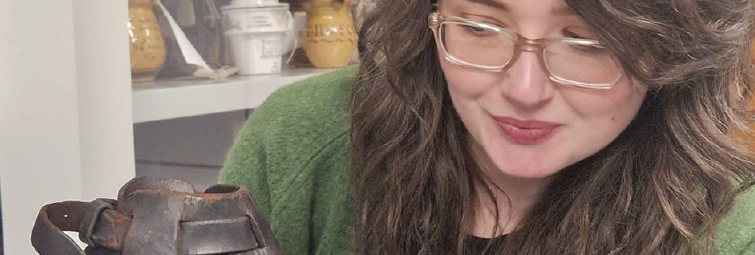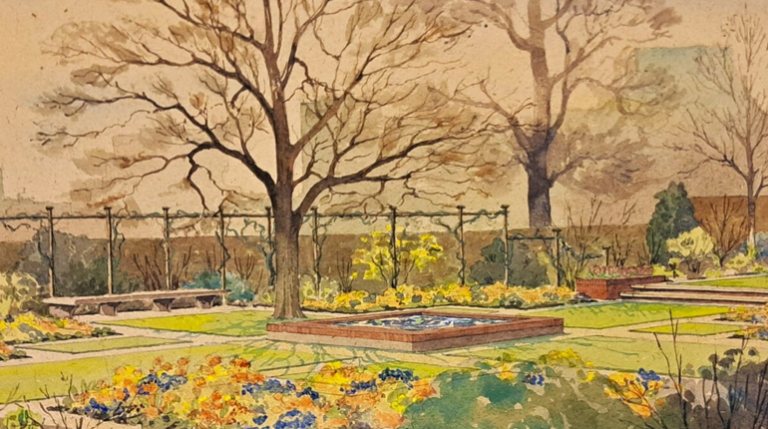Wild Being: how museums can care for health and wellbeing
Learn about our role in creating social prescribing opportunities for people across Reading.
-
Author
- Joe
-
Published Date
- August 19, 2022

What was Wild Being?
Between August 2021 and June 2022, Wild Being—led by Reading Voluntary Action—was a programme that took an holistic approach to promoting wellbeing across Reading, creating new and varied opportunities for social prescribing. With the support of social prescribing link workers, it featured three key strands of activity across arts and heritage, gardening and growing, and sport. At The MERL, on behalf of Museums Partnership Reading, we acted as the lead for arts and heritage. Meanwhile, the Reading Green Wellbeing Network created opportunities for green health, and Sport in Mind promoted physical activities.The project was supported by the National Academy of Social Prescribing, together with Arts Council England’s Thriving Communities Fund. This fund aimed to bring together place-based partnerships to improve and increase the range and reach of available social prescribing opportunities, especially for those people most impacted by COVID-19 and health inequalities.
What did we do?
For a number of years, we have run collaborative health and wellbeing programmes at The MERL. However, the support of the Thriving Communities Fund enabled us to expand this to more than 200 activities throughout the last year, reaching—we estimate—more than 750 people, many of whom attended more than one event or programme. We worked and designed the programme collaboratively with partners such as Compass Recovery College, Alana House, Age UK, RCLC, Communicare, the social prescribers and those with lived experience.The resulting activities included singing, growing and gardening, mindfulness workshops, a chatty café, and physical health programmes with Sport in Mind and IRDC, such as yoga, yoga for mums and babies, and tai chi. We even had fortnightly board game sessions.
What we learned from Wild Being
Wild Being’s range and variety of activity showcased the many different ways that engagement with heritage collections, spaces and the arts can impact upon our health and wellbeing. The conclusion of Wild Being has allowed us to reflect on participant feedback and provided new insights into how the museum can support the five ways to wellbeing. Here are the main takeaways.1. Museums provide opportunities and spaces where you can connect with the lives of others
People are at the heart of The MERL. The museum is home to many human stories which can be discovered both within the collections and in the fact that the museum acts as a meeting point for people and their ideas. It is a place to discover connections and make links.The feedback to Wild Being showed that the museum activities offered a forum in which participants connected with others and related to other people’s lives, and these came to play an important part in participants’ social calendars. One couple who participated in our Chatty Café described the experience as an ‘excellent lifeline for us both, one of the two times a month that my husband speaks to another human being face to face’.
Many participants found this same experience during the Green Health growing activities that we ran in the museum garden. These programmes promoted social wellbeing through connecting with others and being being part of a supportive group.
Gardening and growing offered an unpressurised environment and gave a focus, which also gave a space for conversations and expressions. ‘Just by gently chatting whilst doing our gardening I could share a feeling if I wanted to’, said a Green Health participant. ‘There was no pressure under the spotlight […] just a sort of natural opening up occurs without realising […] but so beneficial.’ The chance to connect with nature was also valued by participants. ‘It was a real pleasure to spend time outdoors’, one said, ‘connecting with nature in The MERL garden. I probably would not have ventured outdoors on some of the days if there wasn’t a session to go to’.Before I came here, I had lost my confidence. Felt lonely. But meeting all my friends here made my confidence come back. I was waiting for Wednesday to come. I loved it.
2. Museums are places for activity and physical health
Organisations like Mind highlight the importance of regular physical activity and its impact on lowering rates of depression and anxiety across all age groups. They also suggest that ‘exercise is essential for slowing age-related cognitive decline and for promoting wellbeing’.Our partnership work with Sport in Mind and IRDC offered incredible opportunities for rethinking the kinds of physical activities that can take place in the museum. Over the course of Wild Being, the museum became home to a range of weekly tai chi and yoga classes (including sessions for mums and babies).
From the feedback we received, it was clear that a number of our programmes had a physical benefit for participants. Some of these, in turn, had a significant impact on confidence. This included Singing for Health, a musical therapy programme drawing on and inspired by folk.
It has been so good for my mental health. I have loved it so much. I really can’t express the benefit I have got from it. I love singing and to be able to do this in a group is a joy.
3. Museums are forums where you can take notice
With the close attention given in museums to the care and understanding of collections, there is perhaps something intrinsic to them as spaces in which to notice, broaden, and strengthen awareness. Enjoying the moment and being aware of what is taking place in the present is something that Mind describes as having the potential to directly enhance wellbeing. They go on to say that ‘savouring “the moment” can help to reaffirm life priorities’.The Chatty Café was a monthly drop in café at the museum for carers and their loved ones, using our collections as a starting point to conversation and story sharing. Developed with Age UK, it was originally designed for those with dementia and their carers (a social prescribing priority group in Reading during at the outset of the project). But over time, we broadened the sessions and opened them up for a wider (mostly older) audience, responding to need and demand and the many people seeking social interactions lost during COVID.
Feedback from the Chatty Café suggested a real value in having your voice heard and recognised in the moment.Really good to be listened to talking about my life experiences. It’s nice to be able to say something and smile and be listened to.
But for some, the subject matter also involved acknowledging differences, taking notice of others, and broadening awareness of their values. ‘Good to talk to strangers and hear something different about life and experiences’, one attendee said. ‘I’m now confident’, said another. ‘I can talk to people, welcoming them. Before coming here I was shy because I’m not good at English. The more I come, the more confident I become. Every Tuesday I’m now learning English’.
4. Museums provide opportunities for learning
The charity Mind highlights the importance of continued learning through life for enhancing self-esteem, encouraging social interaction, and developing a more active life. Museums act as sites for the sharing of knowledge, where visitors can see, experience and learn something new, but also where they can apply their knowledge and share their stories.Many participants on our Mentored Volunteering programme commented on the knowledge they gained from the experience. One said: ‘I have learned how to talk to people. I’ve learned about the things in the museum. Seen things I’ve never seen before’. Another noted how the experience had changed their perception of museums, highlighting ‘the knowledge you can get from a museum’.
The activities ran throughout Wild Being promoted the development of new skills as well as knowledge A participant on our creative arts course, Wildling Hearts and Healing, said that it ‘really developed [their] exploration of nature, family, countryside, and the past’. The same course offered opportunities for peer-to-peer learning, with one attendee commenting: ‘I enjoyed being in the company of other artists and took on broad ideas and concepts from them and hopefully they took creative ideas from me’.
Elsewhere, two participants of our Reading for Wellbeing course were inspired to continue pursuing their literary interests beyond their time at the museum. One attendee said, ‘I have met some really amazing people and I have been inspired to apply for a creative writing course at the University of Reading. I am waiting to hear back from them. Its an inspiring location and great facilitation. It was wonderful’.
Another was encouraged to start writing again after the course. ‘It was beyond my expectations’, they said. ‘Everyone was so friendly and helpful. I find it difficult to express myself verbally but it didn’t seem to matter to them. I am now confident about going out and meeting other people. I was depressed and now I feel like there is a smile inside me’.I am now confident about going out and meeting other people. I was depressed and now I feel like there is a smile inside me.
5. Museums are spaces where people can give back
For those who undertook the Mentored Volunteering programme and went on to become independent volunteers, many reported that they felt highly motivated by the prospect of ‘giving back’ and playing an active role in the community. ‘I wanted to volunteer to do something for the community’, one volunteer said. ‘And I feel good for doing it. Even when I am not feeling well and my joints ache, I come here and feel glad for doing something. Before coming here, especially during the pandemic, I felt so lonely. Now I feel like a different person’.This backs up findings reported by Mind, that:…participation in social and community life has attracted a lot of attention in the field of wellbeing research. Individuals who report a greater interest in helping others are more likely to rate themselves as happy.
So what next?
The learnings we took from the Wild Being health and wellbeing programmes have laid the foundations for our current programme at The MERL, CARE. Over the coming months, you can enjoy various activities at the museum which explore the holistic ways that a culture of caring underpins museum practice. In the summer so far, this has included our family picnic and our day with Miller’s Ark Farm.Over the autumn, a focus on care and repair will be evident in some of our artist-led workshops, a perfect opportunity to develop skills whilst connecting with others.
You will also discover continued development of our health and wellbeing programme, with partners including Compass Recovery College (Mindful Photography) and Sport in Mind (with the continuation of the weekly tai chi and mums and babies yoga), all designed to support those affected directly or indirectly by mental health or wellbeing challenges.
The exciting programme of creative community and artist-led displays will be continuing, and we’re excited to keep showcasing the stories, curiosity and creativity that museum collections can inspire. Keep an eye on our What’s On, sign up to receive our newsletter, or find out more about our programme for CARE. And finally, if a facilitated experience doesn’t sound appealing, we have free self-led resources you are welcome to use, such as garden trails and even a Museum Peace Mindfulness Guide.
In the meantime, if this blog has raised any questions or has inspired you to discover more about opportunities at The MERL, please contact our Learning and Engagement Team.





